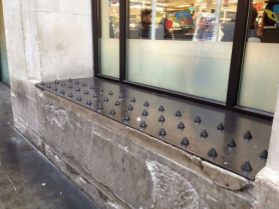Hostile Architecture and the Separation in Our Cities
As of 2021, California has the highest population of homeless people in the U.S., and yet public spaces are intentionally being restricted and policed, affecting the accessibility of local areas and disregarding various communities.
California is the most populated state in the U.S., and the rapidly increasing issue of homelessness is reflected upon the unaffordable housing and large population of people. According to the United States Interagency Council on Homelessness, in January of 2020, there was an estimated total of 161,548 people —in varying backgrounds, age groups, and households—experiencing homelessness in the state of California alone. This made California the state with the highest percentage of people—27.89%—without a home across all states in the U.S. Even with the escalating issue of homelessness, factors of the anti-homeless agenda can be seen through aggressive and restrictive types of architectural design.

Hostile architecture is defined by the MacMillan Dictionary as being “the design of buildings or public spaces in a way which discourages people from touching, climbing or sitting on them, with the intention of avoiding damage or use for a different purpose”. Often found amongst urban cityscape designs, different types of hostile architecture can be found hiding in plain sight and sometimes purposely placed to prevent occupation. “Strategically” placed arm rests, spikes on concrete floors, or oddly curved benches, are all versions of hostility built within the infrastructure of our communities. While this form of architecture can affect all residents of differing communities, it specifically targets homeless people with the objective of discouraging the use of public property in a way not normally intended.
“The problem with hostile architecture is that it doesn’t aim to address the crisis of homelessness. All it achieves is making life harder for those already struggling. Forcing people to find other places to sleep won’t solve the issue of homelessness,” stated in an article by Interesting Engineering. The incorporation of aggressive architecture in our cities makes navigating and managing daily life exceedingly difficult for someone taking on the issue of homelessness.
While the effects of hostile architecture mainly target the homeless community, it creates an unsafe environment for all residents. “Hostile architecture studs the city with danger. These unfriendly surfaces are created with decorative, dangerous adornments that give older structures a medieval fortress quality,” Michelle Legro stated in an article from Topic titled, “The City That Will Never Let You Sleep.” Dangerous designs add to the overall hostility of aggressive architecture, while also making spaces uncomfortable for public use.
In an article from the New York Times it stated, “…public seating is becoming an endangered species. If a park bench is not being removed, the backup plan is often to make it uncomfortable”. Aggressive architecture is never meant for the purpose of design, but more as a way to deter people from occupying public spaces, making it a difficult task for people to find shelter in bustling and crowded cities.
There are also anti-homeless laws that further prevent the accessibility to public spaces. An example would be Los Angeles’s new Anti-Camping initiative. The law was passed this year on September 3rd by LA City Councils and Mayor Eric Garcetti. This law incorporates stricter regulations of where people are legally allowed to sleep and set up tents–making it illegal to inhabit and stay in certain areas near property and other subterranean city spaces.
In an article from ABC News, it stated, “The updated anti-camping law bans sitting, sleeping, lying, storing personal property or otherwise obstructing the public right of way in several areas of the city.” The article goes on to mention some of the restricted areas, “The updated ordinance now allows the L.A. City Council to target so-called ‘sensitive’ locations like schools, day care centers, parks and libraries, and prohibit any kind of camping within 500 feet of them… Other sensitive areas include overpasses, underpasses, freeway ramps, tunnels, bridges and subways.” The removal and criminalization of being able to reside in public areas does not help combat the homelessness crisis in California, but instead further complicates the issue as more laws and regulations are enforced.
Yukana Inoue from The Los Angeles Loyolan stated, “….the implementation of hostile infrastructure is merely treating the symptom and not the problem…” Inoue continues to say, “Forcing the homeless from certain areas in the city by building hostile benches and fences does not cure homelessness. The same people have to go somewhere, and in the long run, it is exacerbating the issue.”
As issues go unaddressed and homelessness becomes more criminalized, the ongoing crisis of homelessness in California continues to persist. Through subtle but dehumanizing architectural actions, it can be inferred that California still has a long way to go in prioritizing their cities and communities.
Check out @hostile.la on Instagram for documented images of hostile architecture in Los Angeles.